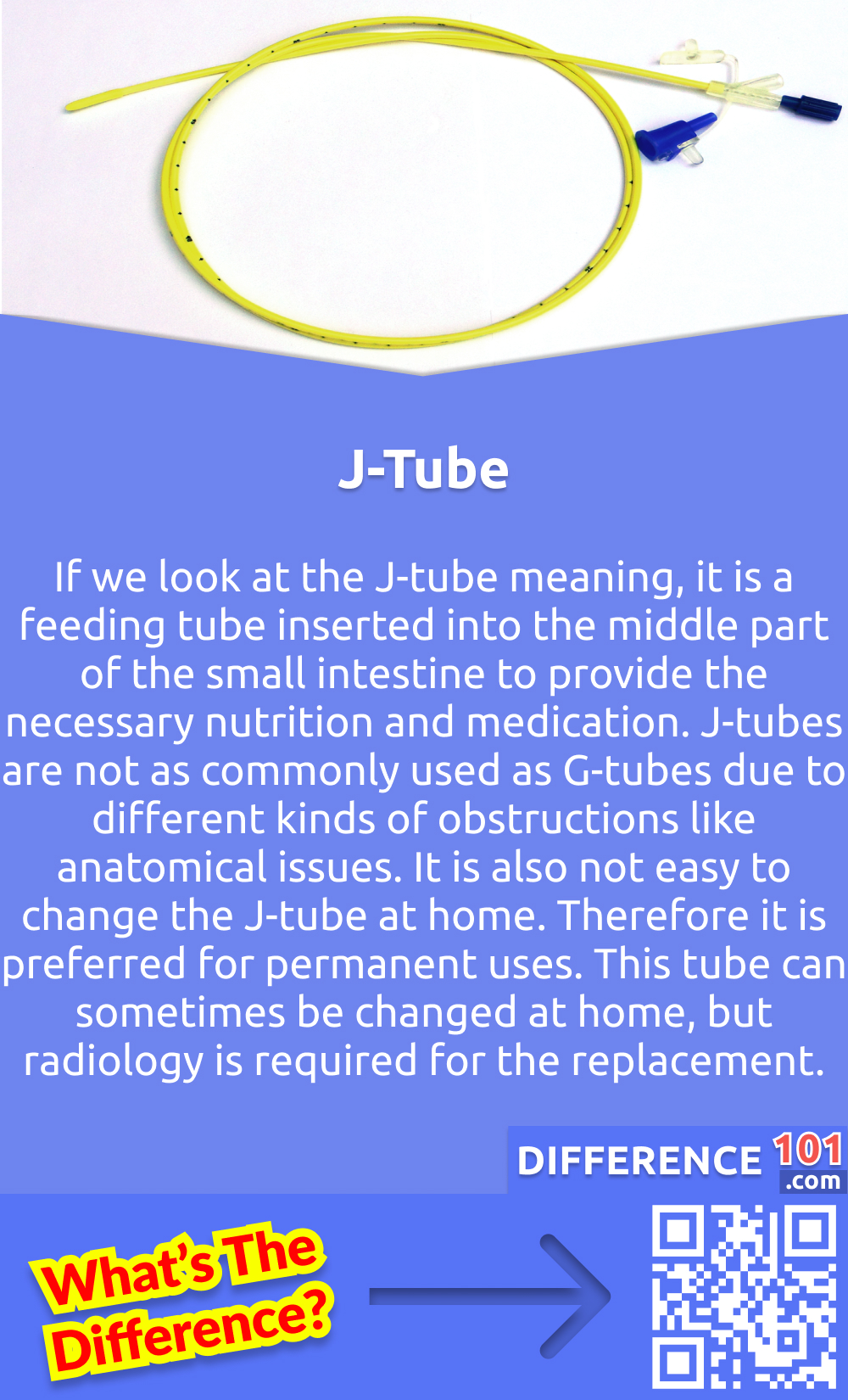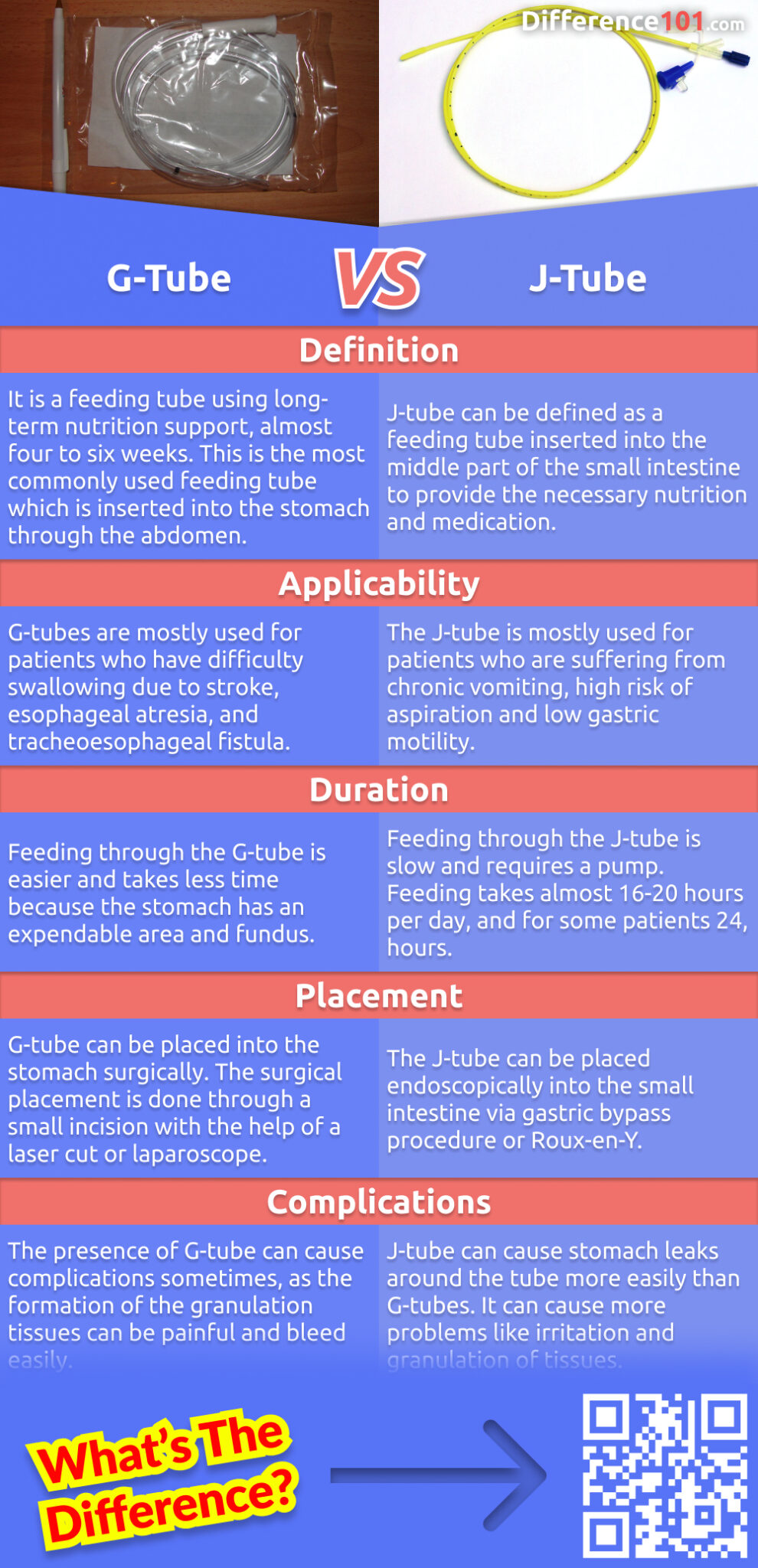J-Tube vs. G-Tube: G-tubes and J-tubes both are medical devices used as feeding tubes to provide nutrients which are not able to obtain food through the mouth. The main difference between the G tube and the J tube is that the G tube is used for long-term nutrition and inserted into the stomach through the abdomen, while the J tube is inserted into the small intestine through the abdomen.
Let’s take a closer look at G-tube vs. J-tubeCalled The G-tube is called a Gastrostomy tube, while the J-tube is a Jejunal feeding tube Comfortable G-tube is more comfortable than J-tube Change At Home Only the G-tube can be changed at home Venable G-tube can be more easily vented than J-tube
Table of Contents
What Is G-Tube?

If we look at the G-tube meaning, it is a feeding tube using long-term nutrition support for almost four to six weeks. This is the most commonly used feeding tube which is inserted into the stomach through the abdomen. This tube can also be used as a gastric drainage in case of a small intestine blockage and can also be vented out to release stomach gasses. G-tube is inserted into the stomach with the help of three different surgeries. The first one is by creating an inside opening via scope. The second one is by a small incision, with the help of a laparoscope. And the last one is through a large incision. The best thing about G-tubes is that they can be easily changed at home as there is not any complicated procedure to change these. There are many different types of G-tubes depending upon the patient’s condition and the surgeon’s recommendation.
What Is J-Tube?

If we look at the J-tube meaning, it is a feeding tube inserted into the middle part of the small intestine to provide the necessary nutrition and medication. J-tubes are not as commonly used as G-tubes due to different kinds of obstructions like anatomical issues. It is also not easy to change the J-tube at home. Therefore it is preferred for permanent uses. This tube can sometimes be changed at home, but radiology is required for the replacement. There are various methods through which a J-tube can be inserted into the small intestine. Some common procedures include open surgery, gastric bypass, and percutaneous endoscopic jejunostomy. J-tubes are used for patients with chronic vomiting, high risk of respiration, and low gastric motility. J-tubes are also inserted in patients where G-tubes can not work. But a J-tube can cause more problems than a G-tube, like irritation and granulation of tissues.
5 Key Differences Between G-Tube and J-Tube
| Components | G-Tube | J-Tube |
|---|---|---|
| Definition | It is a feeding tube using long-term nutrition support, almost four to six weeks. This is the most commonly used feeding tube which is inserted into the stomach through the abdomen. | J-tube can be defined as a feeding tube inserted into the middle part of the small intestine to provide the necessary nutrition and medication. |
| Applicability | G-tubes are mostly used for patients who have difficulty swallowing due to stroke, esophageal atresia, and tracheoesophageal fistula. | The J-tube is mostly used for patients who are suffering from chronic vomiting, high risk of aspiration and low gastric motility. |
| Duration | Feeding through the G-tube is easier and takes less time because the stomach has an expendable area and fundus. | Feeding through the J-tube is slow and requires a pump. Feeding takes almost 16-20 hours per day, and for some patients 24, hours. |
| Placement | G-tube can be placed into the stomach surgically. The surgical placement is done through a small incision with the help of a laser cut or laparoscope. | The J-tube can be placed endoscopically into the small intestine via gastric bypass procedure or Roux-en-Y. |
| Complications | The presence of G-tube can cause complications sometimes, as the formation of the granulation tissues can be painful and bleed easily. | J-tube can cause stomach leaks around the tube more easily than G-tubes. It can cause more problems like irritation and granulation of tissues. |
J-Tube vs. G-Tube Similarities
- Whether it is a J-tube or G-tube, both are medical devices used to provide nutrients to patients unable to feed through the mouth.
- The presence of these tubes can cause complications sometimes, like irritation and granulation of tissues.
J-Tube vs. G-Tube Examples
G-tube Examples
- Low Profile Tubes
- Long Tubes
J-tube Examples
- JEJ-Tubes
- PEG J-Tubes
G-tube vs. J-tube Pros and Cons
G-tube Pros and Cons

Pros of G-tube
- This tube can provide necessary medication and nutrition for the patient who cannot feed through the mouth. It can also be used for gastric drainage.
- Feeding through the G-tube is way faster than the J-tube because the stomach has a fundus and expendable area.
Cons of G-tube
- The surgery done to insert the G-tube can cause irritation and skin infection around the gastrostomy area.
- In some cases, there is a risk of intra-abdominal leakage due to G-Tube.
J-tube Pros and Cons

Pros of J-tube
- J-tube can provide the necessary medication and nutrition for the patients.
- This tube is appropriate for patients suffering from chronic vomiting and a high risk of aspiration.
Cons of J-tube
- Feeding through J-tube is a very slow process, and it takes almost 16-20 hours per day.
- J-Tube can cause leaks around the tube more than G-tube and also has a higher risk of irritation and granulation tissues.
Comparison Chart

Comparison Video
Conclusion
J-tube and G-tube both are medical devices used as feeding tubes to provide nutrients which are not able to obtain food through the mouth. But if we talk about the J-tube vs. G-tube differences, both are used for different applications. G-tube is used for long-term nutrition and inserted into the stomach through the abdomen, while the J-tube is inserted in the small intestine through the abdomen. Moreover, Feeding through the G-tube is easier and takes less time than the J-tube because the stomach has an expendable area and fundus. And if we talk about J-tube versus G-tube comfortability, G-tube is more comfortable.







